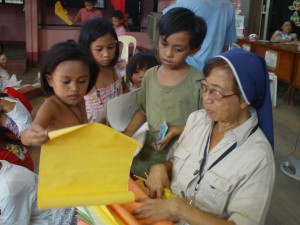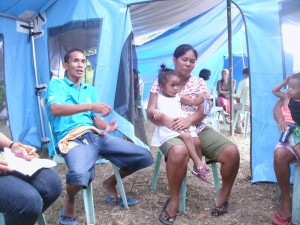 (Sr. Carmelita Arenas and the Good Shepherd Sisters in Cagayan de Oro (CDO), with other Church groups continue to respond to the needs of the victims of the typhoon Sendong that hit CDO and Iligan in December 2011. Following is an update written by Sr. Carmelita.)
(Sr. Carmelita Arenas and the Good Shepherd Sisters in Cagayan de Oro (CDO), with other Church groups continue to respond to the needs of the victims of the typhoon Sendong that hit CDO and Iligan in December 2011. Following is an update written by Sr. Carmelita.)
Sendong Tragedy:
First Response: Relief distribution to the Survivors
Dec. 16, 2011 signified the start of the dawn mass (A Filipino Christian tradition of novena of masses in preparation for Christmas), the longest holiday in the Philippines. But Typhoon Signal # 2 in typhoon free CDO changed all that. The Archdiocesan Social Action Fellowship Day of thanksgiving on December 17 became instant disaster response meeting. The news of the flood destruction, the massive evacuations of peoples, the number of dead and missing changed the pre-christmas spirit to grief. Immediate mobilizations were made to provide the cooked food, the water, clothing, beddings for those in the different camps. Volunteers for the Kitchen, packing and distribution went into full scale action. Relief goods started to pour the first week. Social Action Center , in Camaman-an became the receiving center but due to the location of the Cathedral, truckloads of relief landed in the cathedral ministry office. Volunteers came in twenties and even reached hundreds to sort the sacks of of ukay- ukay or used clothing, the canned goods, the rice, the noodles, the bottles of water. Visits to the different evacuation centers showed families exhausted sleeping on the cardboard in the hall ways but the trek to the communities still buried in mud with the chaos of debris was also heart rending: the fallen trees, the crumpled houses, the broken furniture or just wiped out river bank. For a week or so, there was no electricity, no water. Finally the fire trucks came and the line of people with their buckets and plastics became familiar sight. People, children, dogs and the few belongings filled the 19 evacuation centers. Initial count showed a total of 7,970 families or 39, 850 individuals in 19 centers. News of underserved areas sent the relief workers with packs of rice, canned goods, water, noodles, sardines to distribute. Some donors came directly to the camps or communities to distribute their goods.
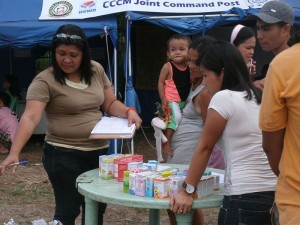 The Good Shepherd Sisters and the women ministry volunteers assisted at the biggest evacuation center, the City Central. First confined to the huge hall, they evacuees were dazed, blank faces, hungry, Distribution of food was long delayed. Decision making unclear. The social workers and volunteers were listing crowds of people. No barangay leaders in the centers in the first week. The city confronted the huge problem of camp coordination and management which necessitated meetings of those involved: the Church, the Department of Social Welfare and Development (DSWD), the City Social Welfare and Development (CSWD). Mobilizations of the people were instant to accommodate the coming of the politicians and other personalities, who distributed money, goods and gave assurance that the government was there for them. After a week of meeting with Dep Ed, the CSWD/DSWD the evacuees were distributed to the rooms. The Daughters of Charity, experienced in disaster intervention, sent in 4 batches of 14-17 sisters to work for 10 days or so, to be replaced by another batch. They helped in the data gathering or listing of the families in the different evacuation centers.
The Good Shepherd Sisters and the women ministry volunteers assisted at the biggest evacuation center, the City Central. First confined to the huge hall, they evacuees were dazed, blank faces, hungry, Distribution of food was long delayed. Decision making unclear. The social workers and volunteers were listing crowds of people. No barangay leaders in the centers in the first week. The city confronted the huge problem of camp coordination and management which necessitated meetings of those involved: the Church, the Department of Social Welfare and Development (DSWD), the City Social Welfare and Development (CSWD). Mobilizations of the people were instant to accommodate the coming of the politicians and other personalities, who distributed money, goods and gave assurance that the government was there for them. After a week of meeting with Dep Ed, the CSWD/DSWD the evacuees were distributed to the rooms. The Daughters of Charity, experienced in disaster intervention, sent in 4 batches of 14-17 sisters to work for 10 days or so, to be replaced by another batch. They helped in the data gathering or listing of the families in the different evacuation centers.
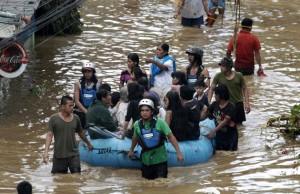 There were many meetings to attend: the multi-sectoral meetings called by CDO Archbishop Antonio Ledesma to assess the situations and discuss the best action plans, the relief, the temporary housing, the roles and tasks of each group. The ACDO Social Action Director Fr. Nathan called for a series of meetings for each ministry to focus on one of the 13 disaster response: Data gathering, Relief Distribution, Supply & Management, Medical & Health, etc. The Clergy met and shared on how they met the needs of their parishioners and thanked those who aided them immediately.
There were many meetings to attend: the multi-sectoral meetings called by CDO Archbishop Antonio Ledesma to assess the situations and discuss the best action plans, the relief, the temporary housing, the roles and tasks of each group. The ACDO Social Action Director Fr. Nathan called for a series of meetings for each ministry to focus on one of the 13 disaster response: Data gathering, Relief Distribution, Supply & Management, Medical & Health, etc. The Clergy met and shared on how they met the needs of their parishioners and thanked those who aided them immediately.
Dec. 30, about 100 medical services were offered to the evacuees in the St. Mary’s High School, including free medicines.
 This was given by a lot of professionals from the academe and hospitals who gave trainings to the local volunteers as well as directly to the survivors in the camps and in the communities.
This was given by a lot of professionals from the academe and hospitals who gave trainings to the local volunteers as well as directly to the survivors in the camps and in the communities.
The Good Shepherd Sisters and the Women Ministry Volunteers helped in the Psycho- social support headed by Dr. Go of the Department of Health. Wednesday meetings updated the Psycho-social cluster on the number of trainings given and the debriefing given to the survivors. Sr. Carmelita joined the debriefing for the survivors, the rescuers and coordinated some trainings for the Church sectors. Many survivors shared many stories of survival, heroism, hope, physical and spiritual strength as well as miracles but the most haunting sound for many was “tabang…” (help) when they themselves s were powerless and at risk of drowning.
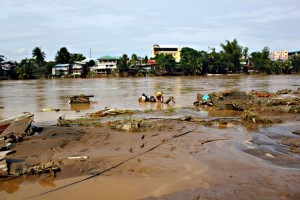 On the 40th day after Sendong, the multi-sectoral group made a touching candle vigil on the bridge. Testimonies came from the survivors, the rescuers and the volunteers. Names of the dead and missing were flashed on the huge screen and a lighted balsa or raft with candles and floral wreaths was lowered from the bridge to float on the now still waters of Cagayan River.
On the 40th day after Sendong, the multi-sectoral group made a touching candle vigil on the bridge. Testimonies came from the survivors, the rescuers and the volunteers. Names of the dead and missing were flashed on the huge screen and a lighted balsa or raft with candles and floral wreaths was lowered from the bridge to float on the now still waters of Cagayan River.
The Good Shepherd Sisters and volunteers focused on the visits to the different camps, the City Central, the Iponan, the City West Elementary School, Bulua and others. They conducted group sessions on drawing, coloring, singing and circle talk. They assisted in visits to the families in the different rooms or different evacuation centers, listing the needs of the vulnerable, the disabled , the mothers with small children, the pregnant mothers, the sick for referral. The mothers were grateful for the new clothing for the infants or special food for the babies . The children loved to draw, color and share their stories. But the most reassuring for them was the listening to their stories of survival, their loss, their complaints, their hopes and plans. The daily Mass celebrated by the priests from the cathedral and the seminary consoled and united them. About 10 seminarians were fielded to stay for 10 days with the evacuees, sleeping and eating with them. The people, children were so touched that they cried when the seminarians left.
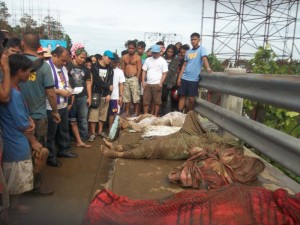 The tragedy of a father committing suicide in front of his youngest son compelled the DSWD, DepEd, the Philippine National Police (PNP) and the Church to monitor more closely the camps . The Archbishop challenged the sisters of CDO to organize their presence in the different camps. Sr. Leah Ann Espina, RGS with the core group from the Association of Women Religious, the Seminary and the volunteers from Social Action to mobilize the service groups to the different camps. Debriefing was made intensive and creative with the influx of many volunteers giving Touch Therapy, Breathing, Body Talk, Acupressure, acupuncture, Art, Drama and Music Therapy. Women Ministry continued with the counseling and debriefing with the evacuees, the students, the teachers, the military, the rescuers and the volunteers
The tragedy of a father committing suicide in front of his youngest son compelled the DSWD, DepEd, the Philippine National Police (PNP) and the Church to monitor more closely the camps . The Archbishop challenged the sisters of CDO to organize their presence in the different camps. Sr. Leah Ann Espina, RGS with the core group from the Association of Women Religious, the Seminary and the volunteers from Social Action to mobilize the service groups to the different camps. Debriefing was made intensive and creative with the influx of many volunteers giving Touch Therapy, Breathing, Body Talk, Acupressure, acupuncture, Art, Drama and Music Therapy. Women Ministry continued with the counseling and debriefing with the evacuees, the students, the teachers, the military, the rescuers and the volunteers
The Dep Ed wanted to normalize the schooling for the children and had to compromise to hold 2-4 hour classes , morning and afternoon sessions, while the families are slowly being moved to the tent cities or temporary housing. Clergy meetings were held as well for the churches/seminaries to open the areas for temporary housing for the evacuees.
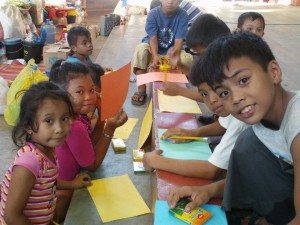 The transfer of the evacuees to the tent cities was another adjustment for the people that made them wary, anxious, and relieved that a better place waited for them, while those left behind found it difficult to wait. The presence of the religious, the many volunteers both local, national and international did alleviate their stress. Psycho-social and spiritual support were continuously given.
The transfer of the evacuees to the tent cities was another adjustment for the people that made them wary, anxious, and relieved that a better place waited for them, while those left behind found it difficult to wait. The presence of the religious, the many volunteers both local, national and international did alleviate their stress. Psycho-social and spiritual support were continuously given.
There were many limitations: the coordination of government agencies , the separation or duplication of tasks, the enormity of the peoples ‘ needs , the crowded space, the emotional vulnerability of the people in their frustration to normalize an abnormal situation, the short term and long term planning, the organization of peoples, the disparity in the distribution of relief to those inside the camps and those who chose to stay in their ravaged homes/communities , the many opportunists who are also poor and in need of the food, relief and other goods, hoping to have a chance for free housing.
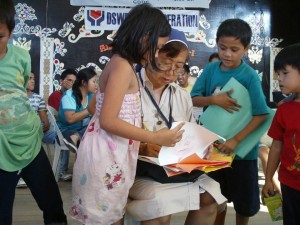 But there were also the blessings: the number of assistance that poured in: both human resources in the medical team, the psychosocial teams from the academe & the hospitals as well as the many relief goods, the medicines, the food, the psychosocial interventions , the laughter and joy from the cultural and art groups, the many alternative healers and support.
But there were also the blessings: the number of assistance that poured in: both human resources in the medical team, the psychosocial teams from the academe & the hospitals as well as the many relief goods, the medicines, the food, the psychosocial interventions , the laughter and joy from the cultural and art groups, the many alternative healers and support.
Photo: Sr. Carmelita with Sendong survivors
The generosity of the international agencies and peoples, the volunteers from the different provinces, the Mindanaons, the multi-sectoral groups abound and gave hope to a devastated people. The greatest challenge is the organization/coordination of the helping people and the mobilization of the initiatives of the dislocated communities . There is the willingness to learn, to work in teams, to give time, talent, treasures, to struggle and overcome the differences, to constantly meet, to critique and assess the situation and response as well as see the gaps in the services, to go beyond the differences and unite in the effort to provide the appropriate response to the needs of a people to build anew their lives. The struggle is not over for many.
As of now, there are efforts of the people in the tent cities to engage in small income- generating by their own initiative. Social Action states that sewing machines and tricycles are being distributed. There is the organizing of the peoples in the devastated areas as well as in the tent cities to prepare for the livelihood projects.
Phase IV: Permanent Housing
This is ongoing through the initiatives of the city, the provincial, the multi-sectoral alliance and the church sector.
- Sr. Carmelita Arenas RGS

